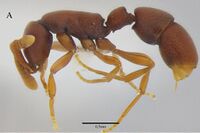Probolomyrmex cegua
| Probolomyrmex cegua | |
|---|---|

| |
| Scientific classification | |
| Kingdom: | Animalia |
| Phylum: | Arthropoda |
| Class: | Insecta |
| Order: | Hymenoptera |
| Family: | Formicidae |
| Subfamily: | Proceratiinae |
| Tribe: | Probolomyrmecini |
| Genus: | Probolomyrmex |
| Species: | P. cegua |
| Binomial name | |
| Probolomyrmex cegua Oliveira & Feitosa, 2019 | |
Specimens of this species come from Reserva Natural Datanlí El Diablo, which is a patchy matrix of private coffee farms and primary and secondary cloud forests. The holotype was obtained from a sifted leaf-litter sample collected in a primary cloud forest, with many large oak trees and abundant tree ferns. The paratype was also found in a leaf litter sample from a montane wet forest, near coffee and agricultural clearings. Both localities are above 1300 meters of altitude.
Identification
Oliveira & Feitosa (2019) - Petiole unarmed; postero-ventral lobe short and evenly rounded; subpetiolar process weakly developed. Prora present; dorsal protuberance on posterior region of first gastral tergite absent.
Probolomyrmex cegua is similar to Probolomyrmex lamellatus, but has propodeal angles, absent in P. lamellatus, and the postero-ventral lobe of the petiole is rounded.
Keys including this Species
Distribution
Latitudinal Distribution Pattern
Latitudinal Range: 13.10974° to 13.09543°.
| North Temperate |
North Subtropical |
Tropical | South Subtropical |
South Temperate |
- Source: AntMaps
Distribution based on Regional Taxon Lists
Neotropical Region: Nicaragua (type locality).
Distribution based on AntMaps
Distribution based on AntWeb specimens
Check data from AntWeb
Countries Occupied
| Number of countries occupied by this species based on AntWiki Regional Taxon Lists. In general, fewer countries occupied indicates a narrower range, while more countries indicates a more widespread species. |

|
Estimated Abundance
| Relative abundance based on number of AntMaps records per species (this species within the purple bar). Fewer records (to the left) indicates a less abundant/encountered species while more records (to the right) indicates more abundant/encountered species. |

|
Biology
Castes
Worker
Nomenclature
The following information is derived from Barry Bolton's Online Catalogue of the Ants of the World.
- cegua. Pobolomyrmex cegua Oliveira & Feitosa, 2019: 75, figs. 14, 15 (w.) NICARAGUA.
- Type-material: holotype worker, 1 paratype worker.
- Type-locality: holotype Nicaragua: Jinotega, RN Datanlí El Diablo, 13.09543, -85.85804, 1310 m., 20.v.2011, LLAMA, #Wm-D-04-2-03 (no collector’s name); paratype with same data but 13.10974, -85.86772, 1440 m., 18.v.2011, LLAMA, #Wa-D-04-1-35.
- Type-depository: DZUP.
- Distribution: Nicaragua.
Unless otherwise noted the text for the remainder of this section is reported from the publication that includes the original description.
Description
Worker
(n=2) HL 0.67–0.69; HW 0.41–0.43; SL 0.41–0.43; WL 81–83; PL 0.35–0.37; PW 0.33–0.34; PH 0.28–0.29; TL 1.92–2.93; CI 61–62; SI 61–62; PI 77.5–78.9. Worker description: Frontoclypeal shelflike projection micropunctate. Mandibles foveated, interval between the foveae covered by micropunctures; external surface of mandibular basal margin smooth. Tip of apical segment of antennae bearing different sized pits. Mesopleuron, metapleuron and lateral faces of propodeum alveolate and foveated; alveoli denser just above metapleural gland orifice; opening of metapleural gland narrow, with a smooth anterior region, surrounded rows of hairs. Petiolar node and postero-ventral lobe of petiole with incomplete foveae and micropunctures; subpetiolar process and latero-ventral region of petiole alveolate. Posterior region of second gastral segment with foveae. Space between mesosomal foveae covered by dense pubescence. Pygidium with dense pubescence. Head 1.6 times longer than wide. Hypostomal margin curved. Antennal scapes extend to head midlength, distance from scape apex to of head more than two times pedicel length (SI 61–62). Propodeum emarginated posteriorly on each side by a narrow carina, with teeth at their apexes. Petiole 1.3 times longer than high (PI 77.5–78.9), without projections of any kind; posterior face short, straight, and smooth; postero-ventral lobe short, evenly rounded; subpetiolar process weakly developed. First gastral segment with prora; dorsal protuberance on posterior region of tergite absent.
Type Material
- Holotype: NICARAGUA: Jinotega: RN Datanlí El Diablo, 13.09543, -85.85804, 1310m, 20.v.2011, LLAMA, #Wm-D-04-2-03, (worker) [CASC, unique specimen identifier CASENT0629220].
- Paratype: same data as holotype, except: 13.10974, -85.86772, 1440m, 18.v.2011, LLAMA, #Wa-D-04-1-35 (1 worker) [DZUP, unique specimen identifer CASENT0629183].
Etymology
The name refers to a folkloric figure from Nicaragua, known as La Cegua. She is a woman that walks through the woods and back roads, attracting drunk and unfaithful men and asking them for a ride. She poses as a beautiful lady so, men give her a ride, but when they turn around, instead of beholding the enchanting companion, they see a monster with the skull of a horse and fiery red eyes. The words she speaks to these men are so horrific that the victim goes insane instantaneously and never recovers (Janzen, 2012). The name is applied here as a noun in apposition.
References
- Oliveira, A.M., Feitosa, R.M. 2019. Taxonomic revision of the genus Probolomyrmex Mayr, 1901 (Hymenoptera: Formicidae: Proceratiinae) for the Neotropical Region. Zootaxa 4614 (1): 61–94 (doi:10.11646/zootaxa.4614.1.3).
References based on Global Ant Biodiversity Informatics
- Oliveira A. M., and R. M. Feitosa. 2019. Taxonomic revision of the genus Probolomyrmex Mayr, 1901 (Hymenoptera: Formicidae: Proceratiinae) for the Neotropical Region. Zootaxa 4614: 61–94.


